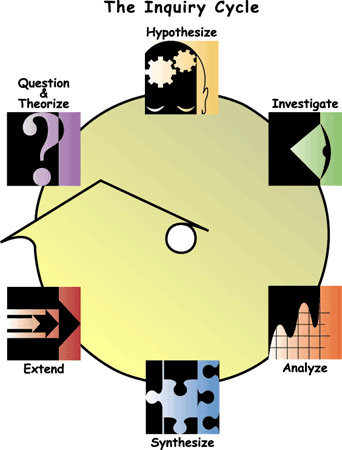
| Curricula | ThinkerTools Inquiry Curricula |
| In the ThinkerTools Inquiry Curriculum, students engage in inquiry using our ThinkerTools software as they formulate and test models of force-and-motion phenomena. The emphasis is on developing students’ metacognitive expertise, particularly their knowledge about the processes of inquiry as well as their ability to monitor and reflect on these processes. The pedagogical strategies include having students make their inquiry goals and products (conceptual models) explicit, supplying materials to scaffold their inquiry processes, and introducing them to methods for monitoring and reflecting on these processes. |
||
| A Goal Structure for Inquiry | ||
Inquiry Cycle |
The curriculum centers around a generic inquiry cycle, which provides a simple model of the inquiry process. This cycle is made explicit to students and is presented as a sequence of goals to be pursued:  |
|
| Question & Theorize | ||
| Hypothesize | ||
| Investigate | ||
| Analyze | ||
| Synthesize | ||
| Extend | ||
| This Inquiry Cycle guides the students’ research and is repeated with each module of the curriculum. As the curriculum progresses, the conceptual models that students are creating increase in complexity. For example, they evolve to take into account the effects of variables such as friction, mass, and gravity. In addition, the inquiry that students are doing is less and less scaffolded. By the end of the curriculum, they are engaging in independent inquiry projects on research topics of their own choosing (e.g., circular motion, collisions, etc.). To guide them in writing their research reports, students are given the Project Outline (shown in the Mass and the Project modules), which augments the Inquiry Cycle by unpacking the goals and subgoals associated with each step. |
||
| Reflecting on the Inquiry Process | ||
In addition to the Inquiry Cycle and Project Outline, which provide students with a goal structure for guiding their scientific inquiry, we also introduce students to a set of criteria for reflecting on their inquiry processes. These include high-level goals such as "understanding the processes of inquiry," cognitively-oriented goals such as "being inventive" and "reasoning carefully," and socially-oriented goals such as "communicating well" and "teamwork." The definitions for these criteria were designed to help students understand the nature and purpose of the cognitive and social processes involved in inquiry. Students are given functional characterizations of what it means to "be inventive," "communicate well," and so forth. For instance, "being systematic" is defined as: "Students are careful, organized, and logical in planning, carrying out, and evaluating their work. When problems come up, they are thoughtful in examining their progress and deciding whether to alter their approach or strategy." Students are then asked to evaluate their own and each other’s inquiry using this set of criteria in a process we call Reflective Assessment. For example, in a typical self-assessment page in the students’ research books, a particular criterion, such as "understanding the processes of inquiry," is defined and students are asked to rate the research they have just completed on that criterion (using a five point scale) and then to justify their rating by describing how their work deserves that score. The aim is to help students learn how to reflect on and improve their inquiry processes so that their future inquiry will have these functional characteristics and achieve these high-level, cognitive and social goals. |